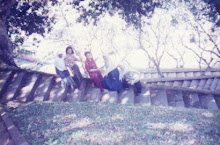 A hotel worker puts food waste into a composter. (PANA) | |
From Food to Fertilizer and Back
Prestigious Hotel Sells Fertilizer
The Palace Hotel in Tokyo is one of the city's oldest. It is also known as a pioneer for turning food waste into fertilizer and animal feed. The Palace Hotel began 10 years ago by recycling the chicken bones used in making the large amount of soup that it serves. By using a crusher and a biofermenter, the chicken bones were processed into material that could be used in pet food, an experiment that was a huge success and provided the motivation for future efforts. These days the majority of the 900 kilograms (1,980 pounds) of food waste--leftovers and pieces of meat and vegetables thrown away during cooking--produced by the hotel everyday are put into a high-speed composter. In 24 hours, the waste is compressed to one-sixth its original size and becomes organic fertilizer. In March 2001 the Palace began selling its fertilizer to nearby farmers at the price of ¥100 ($0.83 at ¥120 to the dollar) for 500 grams (1.1 pounds). The rice and vegetables grown using this fertilizer make their way back into food served at the hotel. What made this system possible is the thorough separation of garbage at all businesses before it is collected.
Large Companies Join in Recycling Effort
Even in the distribution sector companies are actively undertaking similar measures. Daiei (site in Japanese only), operator of the nation's largest chain of supermarkets, passes on 10 tons of food waste produced each day at its processing center to disposal facilities in neighboring prefectures. The waste is made into fertilizer, and the vegetables grown with it end up on the shelves of Daiei supermarkets as a special brand, sales of which reached ¥140 million ($1.17 million) last year. Lawson, a convenience store chain, is carrying out a similar program. Box lunches and vegetables whose freshness date has expired are picked up by a company that disposes of the food and processes it into fertilizer. This fertilizer is then sold to contracted farmers who grow vegetables. The new vegetables are used as ingredients for box lunches again. A growing number of shops, and even department stores like Seibu and Keio, are reducing garbage and creating fertilizer by installing driers and composters to handle their food waste.
Food makers are also addressing the issue on a grand scale. Soy sauce maker Kikkoman, working jointly with a paper manufacturer, devised a method of combining with paper the 27,000 tons of waste generated in the production of soy sauce, making products like letter paper. There are even some fertilizer manufacturers that collect the compost that gyudon (beef bowl) chains and the like have created from food waste and remove oil harmful to crops before they sell it to farmers as fertilizer.
Toward a Recycling Society
The amount of garbage produced is increasing every year, and Japan's current annual figure is 500 million tons. Of this amount, 100 million tons comprise food and other general waste produced by homes and various kinds of businesses. In many cities garbage is sorted into burnable waste, unburnable waste, recyclable waste, and oversized waste before it is collected and then disposed of by local governments. Some areas require residents to sort their recyclable waste even further, separating glass bottles, aluminum cans, newspapers, and PET bottles.
In addition to these measures to reduce garbage, the new Food Product Recycling Law has made it mandatory for businesses that handle food, such as food makers and distributors, to recycle food waste as a way of promoting the reduction and reuse of garbage.
While homes are exempt under the current law, a number of communities and local governments have begun moves to promote the voluntary recycling of food waste. One of the communities attracting a lot of attention for this is Nagai City, Yamagata Prefecture. Twice a week the residents of that town take food waste that has been drained of water to a garbage dump, where they put the waste in special collection buckets. Over half of the 5,000 households in the city are taking part, and 1,500 tons of food waste are recycled annually. This waste is turned into compost using city facilities and is then sold to farmers through the local agricultural cooperative. The crops grown using this fertilizer are sold within Nagai. The city began this program in 1997, and the amount of food waste produced every year has since fallen by more than 30%.
Simple machines that can be used to dispose of garbage at home are also beginning to become more common. Through efforts like this, Japan is moving forward one step at a time toward making a recycling society a reality.
(Web-Japan, November 30, 200)






